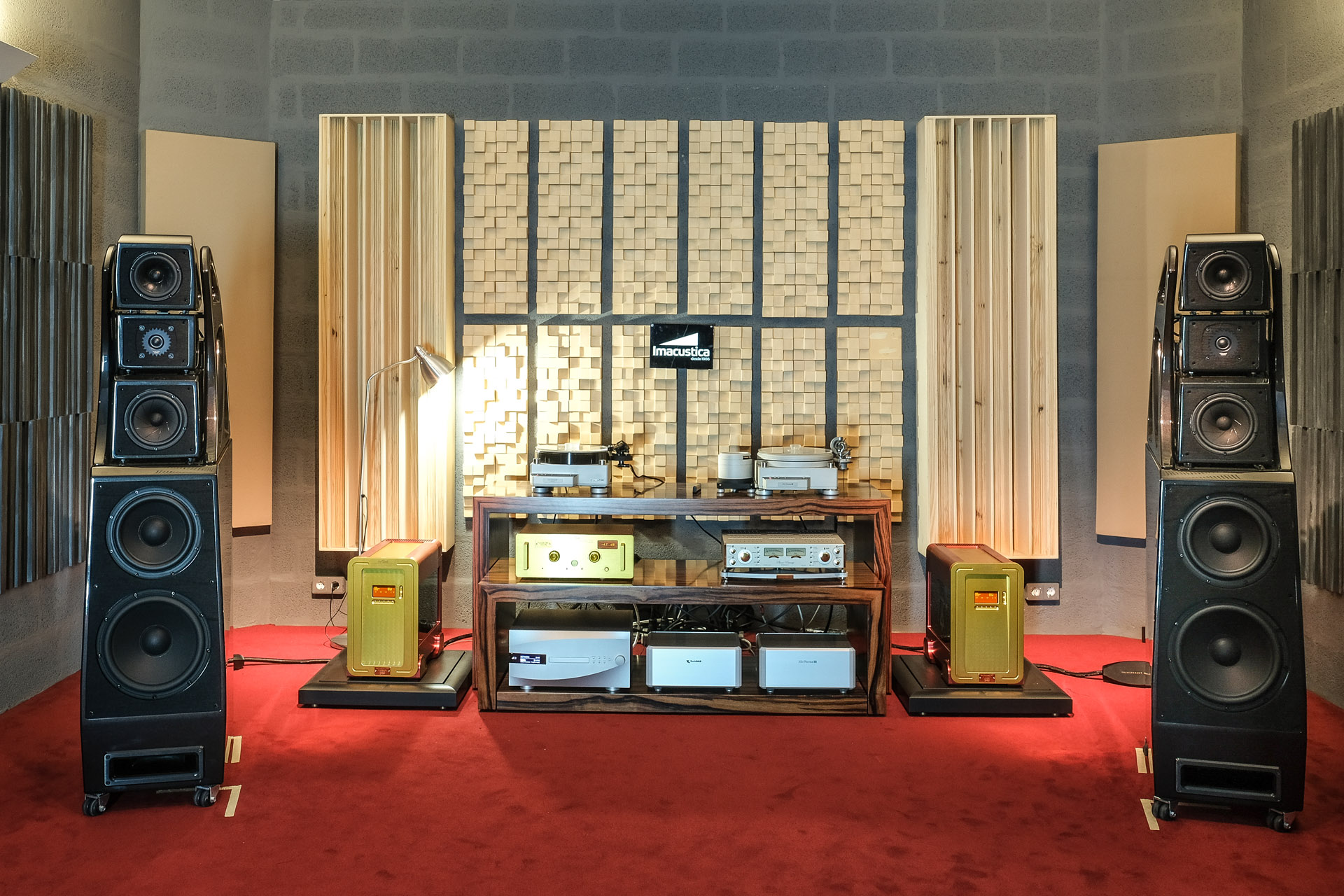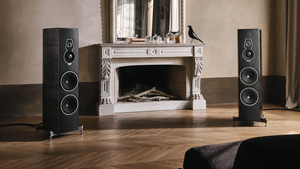
Wilson Audio Alexx V: Redefining Sonic Royalty
I. Introduction: An Heir to the Throne
In the rarified air of ultra-high-end audio, the arrival of a new flagship-adjacent loudspeaker from a manufacturer like Wilson Audio is not merely a product launch; it is a seismic event. It signals a shift in the landscape, a new declaration of what is sonically possible. Such is the case with the Alexx V. This loudspeaker was born with the unenviable task of succeeding the original Alexx, a transducer that, since its 2016 debut, had firmly established itself as a reference point and a multi-award-winning benchmark in its formidable price class. To replace such a revered component is to invite scrutiny of the highest order. Wilson Audio’s response was not a subtle iteration, but a comprehensive re-engineering that draws its very lifeblood from the company’s most ambitious and cost-no-object research programs.

The "V" in its designation is not the Roman numeral for five, but a direct reference to V-Material, a proprietary composite central to the new design's performance. More than that, it signifies a convergence—a deliberate and methodical distillation of the genetic code from Wilson's loftiest creations, the monumental WAMM Master Chronosonic and the Chronosonic XVX. The Alexx V is, in essence, an heir to the throne, inheriting the architectural principles, material science, and driver technologies developed for loudspeakers that exist in a realm where cost is no longer a consideration. The result is a product that aims to deliver a substantial portion of that ultimate performance in a form that, while still imposing, is conceived for a broader range of listening environments.
To truly comprehend the Alexx V, one must look beyond its individual components and understand the foundational philosophy that underpins its existence. Wilson Audio does not simply build loudspeakers; it engineers highly sophisticated, mechanically adjustable platforms for musical reproduction. The central thesis of this platform-based approach is the uncompromising pursuit of two interconnected ideals: temporal accuracy and the absolute minimization of cabinet-induced vibration. Every design decision, from the exotic, proprietary materials that form the enclosures to the intricate, micrometer-adjustable modules that house the drivers, serves this dual purpose. The materials are chosen to create an acoustically silent, inert foundation—a stable launchpad from which sound can emerge without the smearing influence of resonance. The mechanical architecture, in turn, is designed to allow for the precise alignment of each driver's output in the time domain, ensuring that the harmonic structure of the music arrives at the listener’s ear as a coherent, unified whole. The sonic virtues so consistently praised by critics—the profound silence between notes, the holographic imaging, the startling dynamic realism—are not happy accidents but the direct, predictable outcomes of this holistic, system-wide engineering discipline. The Alexx V is the latest and most refined expression of this platform philosophy outside of the company's ultimate flagships, a testament to an unwavering, decades-long quest to eliminate the loudspeaker from the sonic equation and leave only the music.

II. Form Follows Function: A Study in Material Science and Architecture
The physical presence of the Alexx V is one of sculptural complexity, a form dictated not by arbitrary aesthetic choices but by the rigorous demands of acoustic science. Every curve, every material, and every mechanical interface is a solution to a specific engineering problem. To analyze its architecture is to understand how Wilson Audio translates its core philosophies into tangible, high-performance hardware.
The Skeleton Key: Open-Gantry Architecture
Perhaps the most visually striking evolution from its predecessor is the Alexx V’s adoption of an open-architecture gantry system, a design element passed down directly from the Chronosonic XVX. Where the original Alexx featured solid side-cheeks for its upper-module array, the Alexx V employs a "skeletonized" structure. While this significantly reduces the speaker's visual mass and imparts a more graceful, slender appearance despite its considerable height, its primary purpose is acoustic. Wilson Audio claims this open framework eliminates the semi-enclosed areas that could trap pressure waves in the previous design, while also improving lateral wave diffraction. This architectural change is a direct contributor to the speaker’s ability to project an exceptionally wide and deep soundstage, allowing the acoustic image to form freely in space, untethered from the physical location of the enclosures.
The Science of Silence: Proprietary Composites and Vibration Control
At the heart of Wilson's design is a fanatical devotion to controlling resonance through material science. The Alexx V is a showcase of the company's latest advancements in proprietary composites. The enclosures are constructed primarily from X-Material, an extremely dense and well-damped phenolic resin composite that Wilson has refined over generations to serve as the ideal "launch pad" for the immense energy generated by bass and treble drivers. For the critical midrange baffles, S-Material is employed, a composite specifically formulated to provide a neutral and natural surface for the midrange drivers to operate from.
The key innovation in this model is the strategic implementation of V-Material. This newer composite is engineered for superior vibration absorption and acts as a constrained layer damping interface. In the Alexx V, it is "nested" in the most critical locations where vibration transmission must be stopped: at the top of the massive woofer cabinet to decouple it from the gantry above, and within the gantry's cross-brace to further isolate the midrange and tweeter modules. This meticulous isolation is responsible for what reviewers describe as the profound silence in the speaker's presentation and the "amazing settling between the notes," allowing micro-details to emerge from an ink-black background.
This philosophy extends to the very feet of the loudspeaker. The Alexx V introduces the Acoustic Diode spike system. This is no simple footer; it is a complex mechanical diode composed of Austenitic Stainless Steel and a core of V-Material. The design functions as a one-way gate for energy. The immense weight of the speaker is concentrated onto the tiny spike tips, creating extremely high pressure (
The Voices of the Ensemble: A Unique Driver Philosophy
In an industry often captivated by exotic driver materials like diamond or beryllium, Wilson Audio charts a deliberately conservative course. The Alexx V employs drivers made from seemingly traditional materials: hard paper pulp for the two woofers (a 10.5-inch and a 12.5-inch unit), doped paper pulp for the two dissimilar midrange drivers (a 5.75-inch and a 7-inch), and a doped silk fabric dome for the 1-inch tweeter. This is not a matter of cost-cutting but a conscious philosophical choice. Wilson's engineers prioritize drivers that exhibit predictable, well-controlled behavior far beyond their crossover points, which is essential for achieving seamless integration with their preferred low-slope crossover designs. The focus is less on the raw material and more on the exhaustive refinement of the entire driver system—motor, cone, and suspension—to meet their exacting specifications for a specific application within the loudspeaker system.
While the base materials are traditional, the drivers themselves are highly advanced:
-
Convergent Synergy Carbon (CSC) Tweeter: This new tweeter, first developed for the Alexx V, features an intricate, innovative rear-wave chamber that is 3D-printed in-house from carbon fiber. This complex structure is designed to absorb the back-wave energy from the silk dome more effectively, resulting in a tweeter that is said to be dramatically more resolving and detailed than its predecessor.
-
QuadraMag Midrange: The 7-inch upper-midrange driver is a direct descendant of the unit developed for the Chronosonic XVX. It utilizes Wilson's QuadraMag design, which combines four separate Alnico magnets in a unique "quadrature geometry." Alnico, a material known for its rich and natural tonal properties, is leveraged here to enhance the nuance and texture of the all-important midrange.
-
WAMM-Derived Woofers: Both the 10.5-inch and 12.5-inch woofers were originally developed for Wilson's ultimate statement piece, the WAMM Master Chronosonic, ensuring that the low-frequency foundation of the Alexx V is of the highest pedigree.
Mastering Time and Space: The Aspherical Propagation Delay System
The modular construction of the Alexx V is the physical manifestation of Wilson Audio's obsession with time-domain accuracy. The upper gantry is not a static frame but a highly precise adjustment mechanism that Wilson calls the Aspherical Propagation Delay system. Each of the three upper modules—the two midranges and the tweeter—can be independently moved forward or backward relative to the woofer cabinet and each other. This allows a trained installation expert to physically align the acoustic centers of each driver for a specific listening chair's position and ear height.
The precision of this system is extraordinary. The tweeter can be adjusted to within 1/16 of an inch, which corresponds to a time differential of less than 5 microseconds (, is easily audible, altering the focus and coherence of the soundstage. This fanatical attention to temporal alignment, with an accuracy of down to 8
in the Alexx V, is the primary reason for the speaker's legendary ability to create a soundstage of holographic depth and pinpoint imaging accuracy.
This ethos of adaptability extends to the bass frequencies through the XLF (Cross-Load Firing) port system. A large, machined aluminum port can be mounted on either the front or the rear of the woofer enclosure. This allows the speaker's low-frequency output to be optimized for its position in the room, either firing forward into the listening space or back towards the front wall for different boundary reinforcement characteristics. In practice, this simple change can have a profound effect on the bass quality and integration, and reviewers have noted a clear preference for one configuration over the other in their specific rooms.
The sum of these features—the ultra-fine time alignment, the reversible woofer port, and the meticulous on-site installation process—reveals a deeper truth about the Alexx V's design. It is not a loudspeaker with a single, fixed sonic character. It is an adaptable acoustic instrument, engineered from the ground up to be precisely tuned to its environment. This challenges the conventional notion of a speaker review, as the performance is not a static property of the box but a potential that is fully realized only through expert, in-situ optimization. This inherent flexibility allows a loudspeaker of this scale to perform with startling success even in moderately sized rooms, where lesser large speakers would overwhelm the space. The design is a profound statement that the final frontier of performance lies not just in the speaker itself, but in its perfect integration with the listening space.
III. The Audition: Capturing the Performance
Describing the sound of the Wilson Audio Alexx V is akin to describing a force of nature. It is an experience that engages the listener on a visceral and emotional level, often leaving even the most seasoned critics searching for new superlatives. Synthesizing the collective listening impressions reveals a consistent set of extraordinary sonic traits that define this loudspeaker.
The Unbroken Tapestry: Coherence and Integration
The first and most fundamental triumph of the Alexx V is its absolute coherence. Despite employing five drivers of three different materials covering a vast frequency range, the speaker speaks with a singular, unified voice. There is no perceptible sense of handover between the woofers, the midranges, and the tweeter. The crossover points are sonically invisible, and no single driver imparts its own distinct character on the music. The result is a presentation that is utterly seamless, flowing from the deepest subterranean notes to the highest airy shimmer as an unbroken whole. This masterful integration is the bedrock upon which all of the speaker's other sonic achievements are built, a testament to the synergy of its crossover design, driver selection, and time-alignment capabilities.
The Power and the Glory: Unparalleled Dynamic Expression
If there is one quality that defines the Alexx V, it is its breathtaking dynamic prowess. Reviewers consistently praise its seemingly limitless headroom, a quality described as "unburstability". This is not simply the ability to play loud; it is the ability to reproduce the full-thickness dynamic range of a recording at any listening level without a hint of strain, compression, or tonal shift. Whether playing a massive orchestral crescendo or a delicate pianissimo passage, the scale and character of the instruments remain utterly constant.
This ability is often compared to the immediacy of large electrostatic panels, but the Alexx V delivers this quality without the inherent dynamic limitations or lack of ultimate weight that can characterize electrostats. When listening to a powerfully dynamic piece like the 'Ode to Joy' from Beethoven's Ninth Symphony, the full force of the orchestra and choir can swell to fill the room, with each bass drum beat creating a palpable pressure wave. Yet, when the volume is turned down, the presentation does not shrink to sound like a smaller orchestra or one playing far away; it simply sounds like the full orchestra, just quieter. This is an exceptionally rare and remarkable achievement for a conventional cone-and-dome loudspeaker. This mastery extends from the grandest macro-dynamic swings to the most subtle micro-dynamic shadings—the tiny fluctuations in volume that define a musician's expressive touch—which are rendered with startling realism and clarity.
The Architect of Sound: A Holographic Soundscape
The Alexx V is an architect of vast, immersive acoustic spaces. The soundstage it projects is consistently described as "vast," "expansive," and "holographic," extending far beyond the physical boundaries of the speakers in width, depth, and, notably, height. The open-gantry design contributes to a presentation where the speakers themselves sonically vanish, leaving a cavernous, three-dimensional stage populated by performers.
Within this grand stage, the imaging is nothing short of "razor-sharp". Instruments and voices are locked into place with unwavering stability and focus, allowing the listener to easily sort out even the most complex and cluttered recordings, such as Flying Lotus's You're Dead!. One of the most astonishing demonstrations of this speaker's spatial prowess is its ability to reproduce out-of-phase recording effects with uncanny precision, with some sounds materializing and converging with the same razor-like focus behind the listening position. This indicates a profound ability to resolve the most subtle spatial cues embedded in a recording, transforming the listening experience from a two-channel presentation into something approaching a fully immersive, multi-dimensional event.

A Harmony of Tones: Full-Spectrum Analysis
Across the entire audible spectrum, the Alexx V delivers a performance characterized by balance, speed, and an intrinsic sense of rightness.
-
Bass: The low-frequency performance is a masterful blend of immense power and startling agility. The dual woofers can plunge to the depths required by the most demanding electronic or orchestral music, delivering bass with a silent force and superb grip that can physically pressure-load the room. Yet, this power is never plodding or overblown. The bass is described as "very fast," starting and stopping with an immediacy that belies the size of the drivers. There is a complete absence of the lingering flabbiness or overhang that can plague lesser ported designs. Some reviewers have noted a deliberate "mild dip" in the low-bass response just before the reflex port's output takes over. This is a specific design choice by Wilson Audio intended to make the speaker integrate more gracefully into a wider variety of real-world listening rooms by mitigating boundary-induced boom.
-
Midrange: The midrange is where the soul of the music resides, and it is here that the Alexx V is truly magical. It possesses that special Wilson quality of conveying the "lifelike, human aspect of vocals, string instruments, and natural percussion" with a palpable sense of realism. The presentation is a mixture of presence, openness, and attack, yet it is rendered with an unprecedented level of transparency and focus, completely free of coloration, hardness, or electronic edge. Vocals, in particular, are projected with spot-on height and a sense of humanity that is deeply engaging.
-
Treble: The new CSC tweeter contributes to a top end that is seamlessly integrated with the rest of the frequency range. It is supremely detailed, clean, and expressive, revealing the finest textures and harmonics in the music. Transients are rendered with startling speed but are never hard, sharp, or aggressive. The overall tonal balance is described as intrinsically 'right,' allowing the speaker to sound articulate and refined from the deepest bass notes to the highest treble overtones, making even recordings played thousands of times sound "shiny and new like the first time".

IV. The Summit of Sound: A Comparative Analysis
To situate the Wilson Audio Alexx V in the pantheon of elite loudspeakers requires more than an evaluation in isolation; it demands a nuanced comparison against its peers. The ultra-high-end market is not a monolith but a collection of distinct philosophical approaches to the problem of sound reproduction. Each leading manufacturer has a unique identity, forged through decades of research into materials, driver technology, and acoustic design. The Alexx V, with its emphasis on time-domain realism and dynamic expression through proprietary composites, finds itself in a fascinating dialogue with rivals who champion different paths to sonic truth, whether through absolute material purity, extreme cabinet inertia, or total user adjustability.

Table: A Clash of Philosophies—Design Principles of the Ultra-High-End
| Feature / Philosophy | Wilson Audio Alexx V | Magico M-Series / S-Series | Rockport Technologies Lyra | YG Acoustics Sonja Series | Focal Grande Utopia EM Evo |
| Core Design Principle | Time-Domain Accuracy & Dynamic Realism | Absolute Neutrality & Minimum Distortion | Extreme Cabinet Inertia ("Self-Noise" Elimination) | Phase/Time Coherence & Low Distortion via Precision Machining | Total Adjustability & Dynamic Purity |
| Enclosure Material | Proprietary Composites (X, S, V-Material) | Machined Aluminum with Carbon Fiber (M-Series) or Extruded Aluminum (S-Series) | Dual-Shell Cast Aluminum with Viscoelastic Damping Core (DAMSTIF™) | Precision-Machined Aircraft-Grade Aluminum | High-Density MDF with Internal Bracing (Gamma Structure) |
| Driver Material Philosophy | Refined traditional materials (Paper Pulp, Silk Dome) for optimal system behavior | Cutting-edge materials (Graphene, Diamond-coated Beryllium) for stiffness/lightness | In-house Carbon Fiber Sandwich Cones, Beryllium Dome Tweeter | In-house machined Aluminum "BilletCore" drivers | Beryllium Tweeter, "W" Sandwich Composite Cones |
| Bass Loading | Ported (Reversible Front/Rear XLF) | Sealed (Acoustic Suspension) | Ported (Reflex) | Sealed (Acoustic Suspension) | Ported, with adjustable Electro-Magnetic (EM) Woofer |
| Signature Sonic Trait | Explosive dynamics, holographic soundstaging, palpable presence | Unflinching transparency, speed, forensic detail, tonal neutrality | "Ink-black" background, stunning transient speed, timbral liquidity | Crystalline clarity, speed, seamless coherence | Immense scale, powerful dynamics, user-tunable sound |

Realism vs. Resolution: Wilson Alexx V vs. Magico M-Series
The rivalry between Wilson Audio and Magico represents one of the great philosophical divides in modern high-end audio. Wilson's approach, embodied by the Alexx V, is a pursuit of what could be termed "perceptual realism." It prioritizes the explosive dynamic contrasts, palpable presence, and holographic soundstaging that create a convincing illusion of live music. This is achieved through the use of proprietary composite enclosures designed for targeted resonance control and refined traditional driver materials chosen for their tonal character and system synergy.
Magico, in contrast, is fundamentally data-driven, pursuing absolute neutrality and the lowest possible distortion through advanced material science. Their M-Series speakers utilize enclosures of carbon fiber and machined aluminum, and employ drivers with diaphragms of Graphene and diamond-coated Beryllium—materials chosen for their unparalleled stiffness-to-weight ratios. The resulting sound is often described as one of unflinching transparency, forensic detail, and breathtaking speed. While some listeners find this presentation to be the pinnacle of accuracy, others perceive it as "dry" or less emotionally engaging compared to the Wilson sound. The choice of bass loading further distinguishes them: the Alexx V's ported design offers greater sensitivity and room-energizing capability, while Magico's sealed acoustic-suspension enclosures are praised for their spectacular tonal and dynamic precision in the bass, albeit often with lower sensitivity. The choice between them is a choice between a speaker that seeks to recreate the feeling of a live event and one that seeks to provide the most uncolored, accurate window into the recording itself.
The Battle Against Resonance: Wilson Alexx V vs. Rockport Technologies Lyra
The comparison with Rockport Technologies, particularly their Lyra model, is a fascinating study in convergent evolution. Both Wilson and Rockport are utterly obsessed with creating an acoustically inert cabinet, but they arrive at their solutions from different directions. Wilson's method is one of heterogeneous construction, using a suite of dissimilar composites (X, S, and V-Material) to strategically damp and control resonance across the frequency spectrum.
Rockport's Lyra takes a more monolithic approach with its heroic DAMSTIF™ enclosure. This construction involves two massive, nested cast-aluminum shells, with the cavity between them completely filled with a custom, high-mass viscoelastic damping compound. The result is a single, massively stiff, highly damped monocoque structure that reviewers describe as feeling like a solid block of lead. Both designs aim to eliminate what has been termed cabinet "self-noise"—the low-level resonant signature that clouds transient attacks, obscures fine detail, and imparts a synthetic patina on instrumental timbre. Sonically, reviewers place the Alexx V and the Lyra in the same rarefied class, both capable of producing a sound of stunning clarity, with transients that emerge from an "ink-black" background with startling speed and purity. The primary difference lies in the aesthetic and material philosophy: Wilson's modular, multi-material form-follows-function design versus Rockport's gracefully curved, impossibly dense, dual-monocoque aluminum structure.
Composite vs. Billet: Wilson Alexx V vs. YG Acoustics Sonja Series
YG Acoustics presents another stark contrast in manufacturing philosophy. While Wilson builds its enclosures from proprietary composites, YG's identity is forged in metal. The company's Sonja series loudspeakers are constructed from aircraft-grade aluminum, precision-machined in-house with tolerances akin to those of a fine Swiss watch. This philosophy extends to the drivers themselves; YG's "BilletCore" cones are not stamped or formed but painstakingly machined from solid blocks of aluminum, a process that removes over 99% of the original material to leave a driver of immense rigidity and structural integrity.
This all-aluminum, precision-machined approach yields a distinct sonic signature. YG speakers are consistently lauded for their crystalline clarity, electrostatic-like speed, and seamless phase coherence. The sound is exceptionally transparent and fast. In forum discussions, listeners often characterize the YG sound as having a more transparent midrange and faster, more precise (if less "punchy") bass compared to Wilson's ported designs. The Alexx V, with its composite enclosures and paper-pulp drivers, tends to offer a presentation with more tonal density, body, and explosive dynamic impact—a sound that is perhaps less about analytical transparency and more about visceral, life-like presence. The choice here is between the machined-metal precision and lightning speed of the YG and the dynamic authority and palpable texture of the Wilson.

An Atlantic Divide: Wilson Alexx V vs. Focal Grande Utopia EM Evo
A comparison with France's Focal, and its flagship Grande Utopia EM Evo, reveals different cultural approaches to state-of-the-art loudspeaker design. Both companies share a belief in the critical importance of time alignment, though they implement it differently. Wilson uses its mechanical sliding-block system for micro-adjustment, while Focal employs its "Focus Time" architecture, where the entire cabinet is articulated like a spine, allowing the separate driver modules to be angled towards the listener via a hand-cranked mechanism.
The more significant divergence is in driver technology and room integration. Focal is a champion of exotic materials, most famously with its signature inverted-dome Beryllium tweeter, prized for its exceptional stiffness and low mass. This contrasts sharply with Wilson's refined silk dome. In the bass, Focal's flagship utilizes a massive Electro-Magnetic (EM) woofer, which replaces a permanent magnet with an electromagnet powered by an external, adjustable power supply. This, combined with a series of crossover jumpers, gives the Grande Utopia an enormous range of user-adjustability to tune its bass and tonal balance to the room and listener's taste. This approach to room integration—achieved through electronic and crossover adjustment—stands in contrast to Wilson's more mechanical approach of the reversible XLF port. Sonically, the Focal Utopia line is known for its immense scale, powerful dynamics, and a sound that has evolved from being perceived as slightly lean and bright to being more balanced and linear in its "Evo" generation. The Grande Utopia offers a highly personalizable sound, while the Alexx V's performance is more singularly defined by the precision of its expert installation.

V. Synthesis: Virtues and Considerations
The Wilson Audio Alexx V is a loudspeaker of profound capabilities and considerable demands. Its position in the upper echelon of high-fidelity audio is well-earned, but like any component engineered to such an extreme, it presents a specific set of strengths and requires a specific set of conditions to achieve its full potential. A balanced assessment reveals a compelling list of virtues alongside important considerations for any prospective owner.
Merits (The Case for the Alexx V)
-
State-of-the-Art Dynamic Expression: The Alexx V's most profound and universally acclaimed strength is its ability to reproduce the full dynamic range of music with an effortlessness that is nothing short of breathtaking. It scales from the quietest whisper to the most thunderous crescendo with no audible compression, strain, or change in tonal character. This "unburstability" allows music to breathe with a life-like energy that is exceptionally rare and deeply engaging.
-
Holographic Soundstaging: The speaker excels at creating a vast, three-dimensional soundscape that is both immense in scale and impeccably defined. The imaging is razor-sharp, with instruments and voices locked into specific points in space with uncanny stability. Its ability to resolve spatial cues extends to creating a sound field that is not only wide and deep but also impressively tall, effectively dissolving the listening room's boundaries.
-
Superb Tonal Coherence: Despite its complex five-driver, multi-module design, the Alexx V speaks with a single, unified voice. The integration between drivers is seamless, resulting in a presentation that is tonally balanced, natural, and free from the sonic seams that can plague lesser multi-way designs. The sound is articulate and expressive from the deepest bass to the highest treble.
-
Remarkable Adaptability: Through its meticulous time-alignment mechanism and the versatile XLF reversible woofer port, the Alexx V is engineered to be tuned to its environment with extraordinary precision. This allows a loudspeaker of its significant size to be successfully integrated into a wider variety of rooms—including moderately sized ones—than its physical footprint might suggest, a feat many of its large-scale competitors cannot easily match.
-
Flagship Pedigree: As a direct beneficiary of the research and development for Wilson's cost-no-object WAMM and Chronosonic XVX projects, the Alexx V offers a significant portion of their performance envelope. It is, as one reviewer aptly put it, a "baby Chronosonic XVX," delivering a taste of ultimate-level performance at a fraction of the flagship price.

Considerations (Points of Deliberation)
-
Demanding Amplifier Load: While the nominal 92 dB sensitivity rating appears benign, the speaker's impedance plot tells a more demanding story. It drops to a challenging 2.0 ohms at 250 Hz, a region rich in musical energy. To unlock the Alexx V's full dynamic potential and maintain control over its massive woofers, an amplifier with substantial power and, more importantly, high-current delivery capability is not just recommended; it is essential. Underpowered or ill-suited amplification will leave much of the speaker's performance on the table.
-
Installation is Paramount: This is unequivocally not a "plug-and-play" loudspeaker. Its ultimate performance is critically dependent on a meticulous, expert installation process. The precise adjustment of the Aspherical Propagation Delay for the specific listening position and the optimal configuration of the XLF port are non-negotiable steps that require trained technicians and specialized tools. The difference between a good setup and a perfect one is not subtle, meaning the quality of the dealer and installer is as crucial as the quality of the speaker itself.
-
Polarizing Aesthetics: The Alexx V's design is a pure expression of "form follows function." Its modular, multi-material, skeletonized gantry is a visual representation of its acoustic principles. While many admire this as a striking piece of industrial art, others may find the aesthetic overly complex, mechanical, or "robotic". Its visual character is as bold and uncompromising as its sound, and it will not blend discreetly into all living environments.
-
Tuned Bass Profile: Wilson Audio has intentionally engineered a "mild dip" in the speaker's low-bass response before the port's contribution becomes dominant. This is a sophisticated tuning choice designed to achieve a more seamless blend with the room and avoid the "one-note boom" that can afflict large ported speakers in typical listening spaces. While this generally results in bass that is exceptionally tight, fast, and articulate, listeners who prioritize a perfectly linear anechoic response or the sheer visceral slam of a slightly elevated low-end might perceive this tuning as a trade-off.

VI. Conclusion: Closer to the Source

Its greatest achievement is not merely its colossal dynamic range or its holographic soundstage, as impressive as those qualities are. Its true magic lies in its ability to render the familiar new again. To take a recording one has heard hundreds, even thousands of times, and to peel back layers of artifice, revealing newfound nuance, texture, and emotional intent. This is the direct result of a design philosophy that relentlessly attacks the two greatest enemies of sonic realism: cabinet resonance and time-domain distortion. By creating an incredibly inert and time-perfect platform, the Alexx V allows musical details to emerge from a background of profound silence, uncolored and unsmeared by the mechanical structure reproducing them.
It is not a loudspeaker without demands. It requires an amplifier of immense capability, a listening space of reasonable proportions, and, most critically, an expert hand to unlock its full potential through meticulous installation. Its aesthetic is a bold and unapologetic statement of its engineering principles. Yet, for those willing to meet its demands, the rewards are commensurate with the investment. The Alexx V does not just reproduce a recording; it reconstructs the performance. It delves deep into the soul of the music, offering not just a sense of realism, but at its best, a fleeting, breathtaking glimpse of reality itself. While the absolute summit of audio perfection may remain an ever-receding peak, the Wilson Audio Alexx V stands on a breathtakingly high plateau, a magnificent testament to the art of the possible.







Comments